Episode 184
What you’ll learn in this episode:
- Why ancient Nubian jewelry is still significant today
- How the Kingdom of Kush rose and fell
- How ancient jewelry motifs, techniques and materials were shared and adapted between cultures
- Why the Museum of Fine Arts Boston has a significant collection of ancient Nubian art, and why it’s being exhibited at the Getty Villa
- Why jewelry is often one of the only pathways to understand ancient cultures
About Dr. Sara E. Cole
Sara E. Cole is Assistant Curator of Antiquities at the J. Paul Getty Museum (Villa). She holds a PhD in Ancient History from Yale University. At the Getty, she is part of the Classical World in Context initiative, which seeks to highlight cross-cultural interactions in antiquity and explore the diversity and interconnectedness of the ancient Mediterranean and Near East through a series of special exhibitions and related publications and public programs. She has curated or assisted with exhibitions of Egyptian, Mesopotamian, Neo-Assyrian, Persian, and Nubian art.
About “Nubia: Jewels of Ancient Sudan” from the Museum of Fine Arts, Boston
October 12, 2022 – April 3, 2023
Getty Villa Museum
For nearly 3,000 years a series of kingdoms – collectively known as the Kingdom of Kush – flourished in ancient Nubia (present-day southern Egypt and northern Sudan). The region was rich in sought-after resources such as gold and ivory and its trade networks reached Egypt, Greece, Rome, and central Africa. This exhibition presents highlights from the Museum of Fine Arts, Boston’s extensive collection of Nubian objects and features superbly crafted jewelry, metalwork, and sculpture exhibiting the wealth and splendor of Nubian society. Learn more about the exhibit at https://www.getty.edu/art/exhibitions/nubian_jewelry/
Photos:
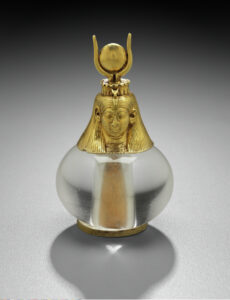
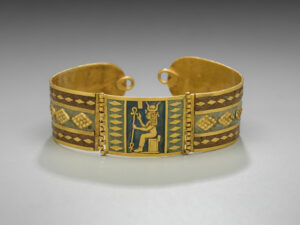
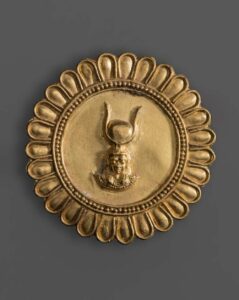
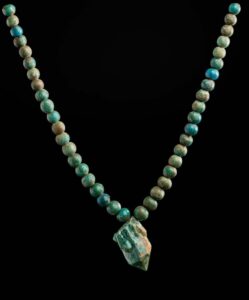
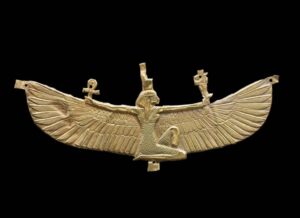
Transcript:
Nubian jewelry is often overshadowed by Egyptian and Greco-Roman jewelry, but the ancient Nubians were the world’s first jewelry pioneers. Their influential work is currently on display at “Nubia: Jewels of Ancient Sudan,” an exhibit at the Getty Villa featuring pieces from the collection of the Museum of Fine Arts in Boston. Dr. Sara E. Cole, assistant curator of the exhibit, joined the Jewelry Journey Podcast to talk about how Nubians developed their own enameling techniques; why jewelry is the key to understanding ancient cultures; and how iconography was shared and adapted throughout the ancient world. Read the episode transcript here.
Sharon: Hello, everyone. Welcome to the Jewelry Journey Podcast. This is the second part of a two-part episode. If you haven’t heard part one, please head to TheJewelryJourney.com.
Today, my guest is Sara Cole, who’s the Assistant Curator of Antiquities at the Getty Villa in Malibu, California. She’s the curator of “Nubia: Jewels of Ancient Sudan,” an exhibit at the Museum of Fine Arts in Boston which showcases Nubian material. These finds were jointly executed early in the last century by Harvard and the Museum of Fine Arts. The exhibit is now open until April 3. Welcome back.
Can you look at a piece of jewelry and say, maybe not exactly where it came from, but the period? It’s late; it’s early? Can you look at one and know?
Sara: To put it in a bigger perspective, something about this collection of material that makes it so special is that it is all from documented archaeological excavations that were carried out in the early 20th century. Jewelry can be quite challenging if you have no context for a piece other than by comparing it stylistically to other known examples. It can be quite difficult sometimes to try to approximate when and where something was made, or to say with 100% certainty that it’s even ancient if you have no context for it. A lot of the same materials and techniques that were used in antiquity are used or can be mimicked today. But with all of this material, it came from documented archaeological excavation, so we know exactly where it was found. Thanks to that context, we are able to say approximately the time period in which it must have been made and used and placed in the tomb. I suppose you could compare other surviving examples with what we now know from the archaeological record, but with this material, we are able to be absolutely certain of its authenticity and the time period in which it was being made and used because we have that archaeological context.
Because Nubia had such a close relationship with Egypt and they engaged in so much exchange, there are some pieces that are found in Nubian contexts that might have been made in Egypt and imported to Nubia. It’s often very difficult to say precisely where something was made because they were using very similar techniques and materials and iconography. So, there are a number of pieces in the exhibition that we think might have been manufactured in Egypt and then imported into Nubia. But even where that’s the case, those objects clearly have value to the Nubians because they speak to their cultural and religious beliefs and priorities.
Sharon: So, people would wear this jewelry in life, the pectorals or amulets. Did they have the same thing in their grave? Were they buried with what they wore, or did they have something special for it? Is it something made just to be buried with?
Sara: It’s both, actually. These royal tombs contained rich assemblages of jewelry. Some of the items do appear, based on signs of wear, to have actually been worn in life and then placed in the tomb with the deceased. There are also pieces that appear to have been made specifically to go in the burial, things that are very, very delicate and seem like they would not have been able to work in real life, or certain objects that are made specifically for funerary contexts.
There’s one piece in the exhibition from the Napatan Period that’s really exquisite. It’s this large, gold repoussé image of the goddess Isis, who is kneeling and stretching her wings out in a protective gesture, but at the tips of her wings and below her legs are these little tabs that each have a hole punched in them. The piece is too delicate, it seems, to have been something that someone would wear in life. And because of those little tabs with the punched holes, we believe it was probably manufactured specifically for this king’s burial, and that it was meant to be sewn into the linen mummy wrappings that were used to mummify his body. Often there were amulets, protective icons, pieces of jewelry that were incorporated into the wrappings during the mummification process. So, it’s both. Some of these pieces were probably worn in life and then taken to the tomb, and some of them were made specifically for the burial context.
Sharon: I’m surprised you can even tell the difference between Egypt and Nubia with the cross-pollination. You talk about Isis. Being an expert, how does somebody know it was Egyptian? The only thing I’ve heard is that earrings were Egyptian. There weren’t earrings before that.
Sara: It’s actually the other way around. This is one of the areas where the Nubians may have influenced the Egyptians. Earrings appear in Nubia before they appear in Egypt, so it’s possible the Egyptians got the idea for earrings from the Nubians. As I mentioned, too, the fly pendant ornament originates in Nubia and gets adopted by the Egyptians. So, there is influence going in both directions, and where the Nubians incorporate Egyptian religious ideas, religious iconography, protective icons, they’re still adapting it. They’re not directly copying it necessarily. They’re adapting it to their local traditions, to the types of materials they work with, to the types of objects and ornaments they make. It’s not necessarily just a direct copy.
In some instances, it is hard to tell whether a specific piece was made in Nubia versus Egypt. But with the burials themselves, we know these are Nubians and not Egyptians because we’re looking not just at the jewelry, but at the overall burial itself, the whole object assemblage, the types of materials they’re being buried with. In addition to the jewelry, there would be things like vessels, pottery, tools, weapons, things that give us a bigger picture. The cultural identity is not just the jewelry, but also the way in which they’re buried and the place in which they’re buried. In the Kerma Period, they used a very distinctive type of burial. They used tumulus burials, these big, beehive-shaped mounds, which was a distinctive type of burial. Over time those mounds get larger and larger, and we can tell that some of them must have belonged to Kerma rulers.
Even though there are now written records during that period, we’re going strictly by the archaeological record. In the Napatan Period, they actually used Egyptian hieroglyphs for monumental inscriptions. We do start to get some written records that we can read, and when these kings’ and queens’ tombs were excavated, there were often items within the tomb inscribed with their names. So, we know who these tombs belonged to, and they belonged to Nubian and Napatan kings and queens. It’s really looking at the big picture and not just at the jewelry specifically to identify who these items belonged to and whose burials they come from.
Sharon: First, I want to know how anybody even knew these tombs were there. Everything you’re describing, at least from the description of what was in the tombs, is what Carter found when he opened the tomb just a few years later, maybe 10 years later. I’m just wondering how they knew these tombs were there. How did they know that? Was it just the beehives that were standing on a farm?
Sara: The material that’s in the MFA Boston was all excavated in the early 20th century, from 1913 to 1932, by a joint Harvard/MFA Boston expedition led by an American archaeologist named George Reisner, who worked in both Egypt and Sudan. He took a team to Sudan that ended up excavating at Kerma, Napata and Meroë. He was tremendously successful in what he discovered, and he essentially rediscovered the city of Kerma. There have been excavations within the city itself, but they also discovered this vast cemetery outside of the city containing tens of thousands of these tumulus burials. Then at Napata and Meroë, they’re utilizing pyramid burials, which are still visible on the landscape. You can walk up to them. He was really the first to do these rigorously documented, professional archaeological excavations of these places, and he found a tremendous amount of material.
I should also mention the way it ended up in Boston is that, at the time, Sudan practiced the partage system, so he finds would essentially be split 50-50. About half the materials remain in Sudan, where it is now in the national museum in Khartoum, and about half the material was allowed to be taken back to Boston by Reisner, where it became part of the MFA collection. So, the MFA is now home to the largest and most significant collection of Nubian archaeological material in the world outside of Khartoum.
Sharon: Did they suspect that there were these kingdoms, but nobody ever found them? Is that what happened? How did he start digging?
Sara: To be perfectly honest, I would have to go back and double check how he determined exactly where he wanted to begin.
Sharon: Why should we care about the Nubians? Why should we care about these kingdoms? You describe how it kept moving further south. That’s usually because of agriculture. What caused them to move, besides invasion?
Sara: That’s a broad question. I don’t know that we necessarily know for certain what was motivating them to move from one city to the next. In terms of the question of why we should care, that’s something we could ask about any ancient civilization. It does raise this broader question about relevance that a lot of audiences are asking.
I would say for Nubia especially, this is the region in northeastern Africa where some of the earliest civilizations of ancient Africa are arising. This is an incredibly important region that was also a real crossroads for international trade, given their connections to the Red Sea, into central Africa, into sub-Saharan Africa, and eventually out into the broader Mediterranean world. This was a very interconnected place with rich natural resources where some of the earliest complex civilizations of ancient Africa arise, so I think we absolutely should care about it.
Speaking in terms of jewelry specifically, this is the place where some of the most exquisitely crafted, sophisticated pieces of ancient jewelry in the world were produced. They were incredibly skilled artisans who developed techniques for working with these materials that in some cases, like I mentioned with the enameling, were believed to have been invented in the modern era until recently.
Sharon: That’s amazing. I always have to think about the fact that they didn’t have electric lights and they had to work by candlelight. They had to deal with sunlight only.
I don’t know exactly how to phrase this, but most of the time, if I were to take a piece from the little room of jewelry at the Getty Villa, and I want to take it out and put it on my wrists, nobody would know the difference. Would you say that’s the same with a lot of this?
Sara: I think so. It always strikes people how contemporary some of these pieces look. They look like things that could have been made today.
Sharon: Were they going back or was this the start of it? Were they going back and building on what had been done before?
Sara: They were really pioneers. They were developing new techniques and new styles for working with this material. In the pre-Kerma phase, in the archaeological record, there are items of personal adornment that are made from things like shell or imported faience sometimes, simple strings of beads, that kind of thing. But then as they develop kiln technology to make pottery, they’re also able to apply that to making faience and eventually glass. They develop, as I mentioned, these very sophisticated techniques for working with different semiprecious stones, for working with gold, for working with glass and enameling. They’re really not looking back to any existing precedent. They are developing these techniques for the first time.
Sharon: That’s amazing. You wonder why each civilization or each culture seems to have certain things that are ubiquitous, like a ram’s head. You wonder, where did it start? What keeps your attention about all of this? Is it the cross-pollination?
Sara: I don’t even know where to begin answering that. I find this material endlessly fascinating. Every time you look at it, you see or appreciate something new, the intricacy of it, or as I mentioned, the ways in which this jewelry for the ancient Nubians is not just a status item. It’s not just something beautiful to look at and wear. It’s imbued with all of these layers of meaning. It reflects so many aspects of Nubian society and Nubian beliefs and Nubian practices. Because of the relative lack of written records from ancient Nubia, we are reliant on the archaeological record. So much of this jewelry helps us more broadly understand ancient Nubian society. I think you can come back to it and look at it over and over again and find new levels of meaning in it every time, as well as being able to appreciate how beautiful it is.
Sharon: But you must have seen a lot of ancient jewelry. You’ve seen Greek and Roman and Egyptian and Nubian. What keeps your attention? What’s so fascinating that it would keep your attention for so long?
Sara: I think everything I just mentioned. The jewelry across ancient societies is fascinating for those same reasons, that it typically is not just about beauty and personal adornment. It’s also reflective of cultural and religious beliefs, but I think it’s the fact that this material is some of the earliest of its kind as well. As I mentioned, they’re pioneers in developing new techniques or adopting techniques from other places and reengineering them as they did with faience, which was being made in Egypt prior to Nubia. They reengineered it, figured out how to make it for themselves. They were developing these unique techniques like the glazed quartz, the enameling techniques. It’s incredible to think that 3,000, 4,000 years ago, people were making these items and developing these technologies and with handmade tools and natural light, and it would be very difficult to control temperatures of a kiln. It’s incredible.
Sharon: It is incredible. I know the Getty Villa is different than the Getty Center. The Getty Villa is a replica of a Roman villa, and it has a little room that has just jewelry. It’s very small. It’s a jewel box of a room, really. Do they have Nubian jewelry in there?
Sara: We do not. We do not own any ancient Nubian jewelry in our permanent collection at the Villa. The Villa is a separate site from the Getty Center. We are home to the Getty Museum’s Antiquities Collection specifically. Our permanent collection of antiquities is predominantly Greek, Roman and Etruscan. This Nubian exhibition is part of a broader initiative we’ve been engaged in in recent years, where we’re trying to bring in special exhibitions featuring material from other ancient cultures and civilizations so our visitors can get a bigger picture of the ancient world. It’s also so we’re not perpetuating this idea that in antiquity, Greek and Roman are all there is. There’s so much more than that. What’s reflected in our permanent collection is Greek and Roman. So, through this special exhibition program, we’re able to highlight other cultures. We also recently had a big exhibition on ancient Persia that included some stunning items of Persian jewelry.
Sharon: I missed that one.
Sara: We don’t have any Nubian or Egyptian jewelry in our antiquities collection, so this is a unique opportunity. As I mentioned, this material is housed at the MFA Boston, so it’s a unique opportunity for people on the West Coast to see a major exhibition of ancient Nubian material, but it is quite different. You can see some stylistic similarities like I mentioned with the Meroitic Period, when they have those trade connections to the Greco-Roman world. You can see stylistic similarities between some of our Greco-Roman pieces and some of the pieces in the Meroitic section of the exhibition, but it is very distinctive. It’s a nice counterpoint.
We have at the Getty a pretty significant collection of ancient, engraved gemstones as well as some Hellenistic gold jewelry and finger rings. You can see similarities. Finger rings with carved bezzles became very popular during the Meroitic Period as well, so you can see some similarities there with the rings being made in the Greco-Roman world.
Sharon: If you haven’t seen the little room with jewelry there, you could take any piece from the Greco-Roman era—and it’s probably true of the Nubian era, too—and put it on, and nobody would know the difference if you went to the market.
Sara: Yeah.
Sharon: Something I came across mentioned the role of women in Nubia, that there was a stronger role. Can you tell us something about that?
Sara: Yes, it seems throughout ancient Nubian history, in the Kingdom of Kush, royal women held particularly high status. We can see that in a few different ways. We can see that in their burials. We can see it some of their individual items of jewelry, which I’ll mention, and we also see it in some of the practices that were being implemented, the roles that royal women had. In the Napatan period, there were a group of royal women who became associated with the god Amun and were sent to Thebes in Egypt, which was the Egyptian center of the worship of Egyptian Amun. These women were made into high priestesses of the god at his temple there. So, they held these very high-ranking, powerful positions, and these were royal women who were relatives of the Napatan kings who were also ruling in Egypt. They had great religious significance in this very important role, where they were sent to Egypt as god’s wives of Amun, what we call them, or high priestesses of Amun.
During the same period, there are some items of jewelry in royal women’s tombs at Napata that speak to their importance. For instance, there’s a piece in the exhibition that is easy to overlook because it’s very small, but it’s definitely worth taking the time to look at. It’s a little silver pendant that shows the goddess Hathor, who I mentioned previously is the goddess of love and fertility and motherhood who gets adopted and becomes very important in the Nubian culture. It’s an image of Hathor, and she is nursing a Nubian queen named Nefrukakashta. The item was found in her tomb. So, she is receiving, essentially, divine lifeforce from Hathor through being nursed by her. This is important because this was also a composition we see in Egypt, but there it’s only the kings who appear being nursed by Hathor. The king is embodying a divine role as pharaoh, so he receives divine lifeforce from Hathor. You never see royal women in ancient Egypt in this pose being nursed by Hathor, but in Nubia, we see it. The status of royal woman is higher there. They’re considered worthy of being show in this position of being nursed by the goddess herself.
By the time we get to the Meroitic Period, the final phase of the kingdom, there’s actually a series of queens who take the throne for themselves and they rule as sole rules. These were very powerful women ruling over the Kingdom of Kush in its final phase, one of whom even famously fought off attempts at invasion by the Roman emperor Augusts. She signed a peace treaty with him to protect the border between Nubia and Egypt, which at that time had become a Roman province. So, royal women in ancient Nubia achieved very high status.
Sharon: I think that’s very interesting. I could talk to you for hours about the history of women and what happened after that. Thank you so much, Sara, for being with us today. I just want to remind you about the exhibit. I listened to a webinar and looked at the press release. It looks like it will be a very interesting exhibit. I look forward to seeing it in person live. It’s through April 13. Dr. Sara Cole is the assistant curator. Thank you very much for being here today.
Sara: Thank you so much for having me.
We will have photos posted on the website. Please head to TheJewelryJourney.com to check them out.
Thank you again for listening. Please leave us a rating and review so we can help others start their own jewelry journey.

